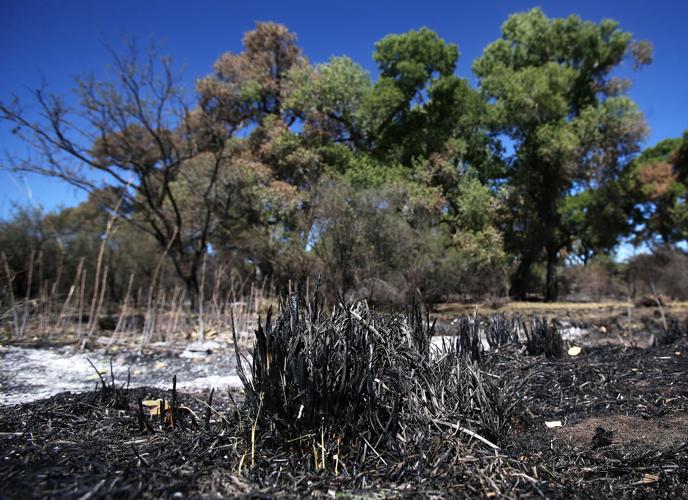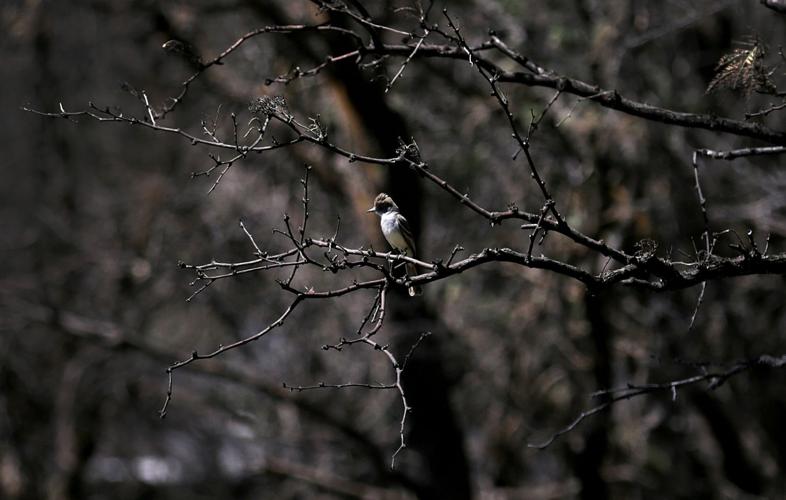Large patches of brown leaves dotted the aging cottonwood trees lining Empire Gulch Tuesday morning.
Below, blackened fields of grass alternated with streaks of white ash on the ground. Many mesquite trees wore blackened surfaces.
But it will be a while before the significance of this superficial scarring of the just-ended Sawmill Fire becomes clear along the gulch or elsewhere in the 42,000-acre Las Cienegas National Conservation Area, officials say.
The blaze burned about 28 percent of the federal reserve, or about 12,000 acres. Much of the burned area was grasslands. But also damaged were stretches of Empire Gulch and Cienega Creek, both considered vital riparian areas serving as home for imperiled fish and frogs. The threatened yellow-billed cuckoo also lives in the cottonwoods and willows along Cienega and Empire, and the endangered Huachuca water umbel lives next to Cienega.
So far, officials haven’t visited much of the conservation area’s burned section because of its fire hazards, said Melissa Warren, field manager for the Bureau of Land Management’s Tucson office, which runs the conservation area. BLM officials gave a media tour of the conservation area Tuesday, but only as far as the Empire Ranch, a short drive from Arizona Highway 83. Its historic buildings adjoin the cottonwood-shrouded Empire Gulch that serves as a tributary to Cienega.
A team of resource specialists will do a full-scale assessment of the damages, but it’s too early to even say how long that will take, Warren said. For now, one of the biggest unknowns is whether ash left behind by the blaze could run off during monsoon storms into one of the creeks and potentially damage or smother native endangered fish.
For now, the conservation area is closed to the public and will probably stay closed until May 8. Even after that, some of it may stay closed until it’s clear that public entry is safe, Warren said. The concern is that cottonwood trees burned in the fire could fall and injure someone, she said.
But several realities are clear, even now. First, the ranch’s 11 buildings escaped damage. That’s because in advance of the fire, BLM officials used “weed eaters” and other devices to remove grass and weeds adjoining the buildings to reduce the fire risk to the buildings that date to the 1870s, said Damon McCrae, a fire management officer for the bureau.
Second, while fire is a destructive force when it attacks homes, it’s often beneficial to the ecosystem in grasslands. That’s true even though this fire was human-caused, started on April 23 by an off-duty Border Patrol agent doing recreational shooting on state land west of Las Cienegas.
Las Cienegas’ grasslands are adapted to fire, will start growing back during the first month after the blaze and should regain most of their vigor in one to two years, said Karen Simms, the manager of the conservation area. It’s now part of BLM’s National Landscape Conservation System.
The recovery time will depend on how much rainfall the area receives, Simms said.
But in the meantime, there will be that much less grassland for the Tomlinson family, whose cattle now graze Empire Ranch, said Simms, adding that the BLM is working on a plan for them to resume grazing. The short- and near-term plans for grazing in that area are still to be determined, Warren said.
For cottonwoods, it’s a different story. Some of the mammoth, 70- to 80-year-old trees above Empire Gulch and Cienega Creek may well have died if the fire penetrated into the heart of their trunks, Simms said. That won’t be known until resource specialists do their assessment. If they do die, it could take another 70 to 80 years for younger trees to replace them in stature, she said.
“It’s perfectly natural for the fire to burn over riparian areas and take out large trees. In that sense, it’s not that big a deal. But if you have habitat for rare birds such as yellow-billed cuckoos, that’s not good for them in the short term,” said Jeff Simms, a BLM biologist.
He said it’s not certain whether ash could affect the endangered Gila topminnow and Gila chub that live in Cienega Creek, and the leopard frog living in both Cienega Creek and Empire Gulch. When the Aspen Fire burned much of Mount Lemmon in 2003, federal officials removed native fish from Sabino Creek to keep them from being smothered by ash running off during monsoon storms after that blaze was extinguished.
This time around, “We may have to do remediation to keep ash from running into the creek during monsoon rains,” said Jeff Simms, who is Karen Simms’ husband. “If there’s enough ash, we could have a fish kill.”
Again, BLM’s Warren said that at this point, there’s not even enough known about the fire damage to know if the bureau will need to form a team to do emergency grass seeding and take other measures to stave off ash runoff.
If there is risk to the fish, “We can hold them in abeyance and put them in a temporary aquatic habitat in aboveground pools” to protect them from flooding and ash flows, Jeff Simms said. Also, unlike Mount Lemmon, the burned watershed in the lands above Las Cienegas is relatively flat, Karen Simms observed.
Summing up the damages, she said, “I don’t know whether we need to be concerned until we go out and do an assessment.”





